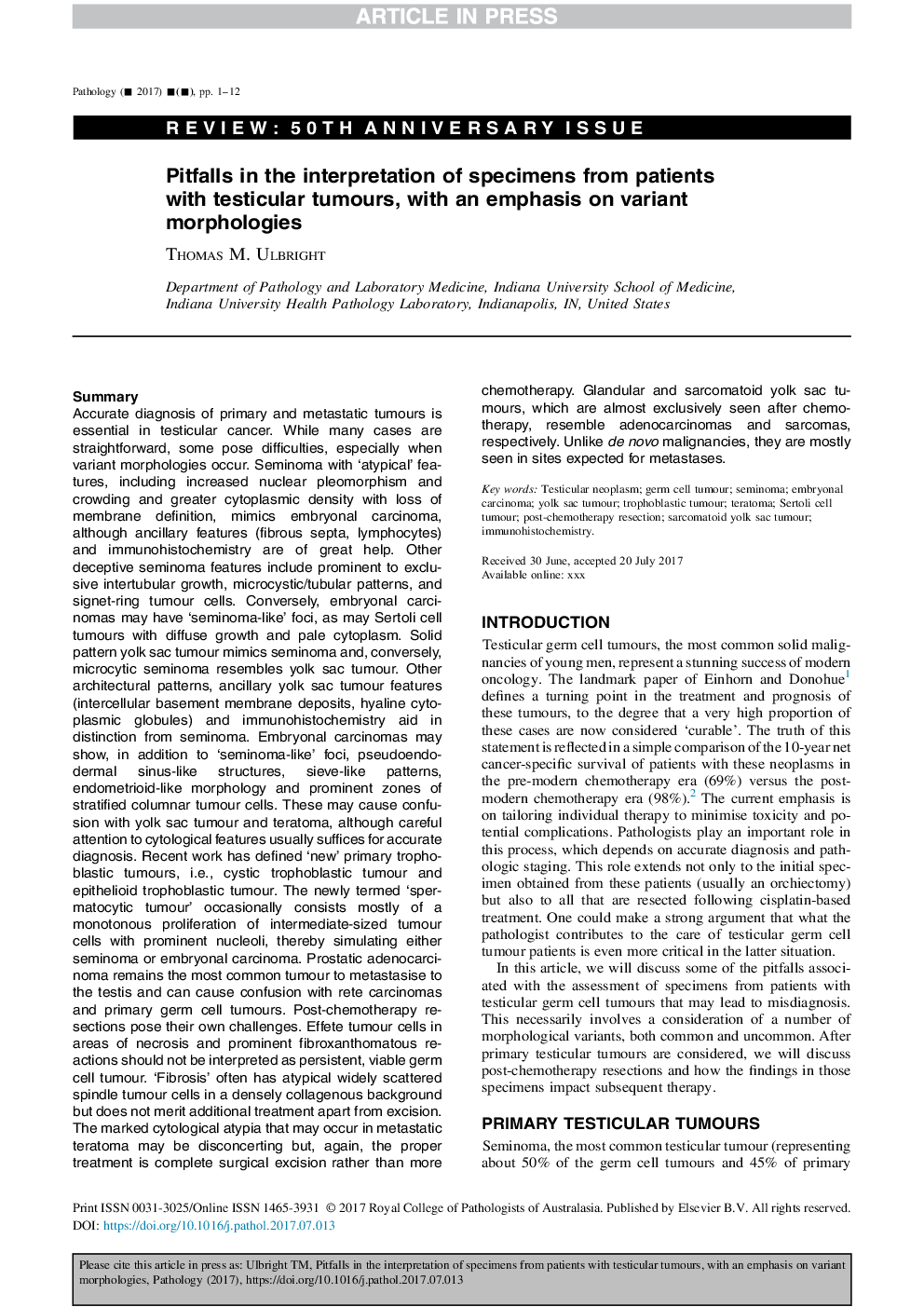| کد مقاله | کد نشریه | سال انتشار | مقاله انگلیسی | نسخه تمام متن |
|---|---|---|---|---|
| 6555584 | 1422486 | 2018 | 12 صفحه PDF | دانلود رایگان |
عنوان انگلیسی مقاله ISI
Pitfalls in the interpretation of specimens from patients with testicular tumours, with an emphasis on variant morphologies
ترجمه فارسی عنوان
مشکلات در تفسیر نمونه از بیماران با تومورهای بیضه، با تاکید بر مورفولوژی انواع
دانلود مقاله + سفارش ترجمه
دانلود مقاله ISI انگلیسی
رایگان برای ایرانیان
کلمات کلیدی
موضوعات مرتبط
علوم پزشکی و سلامت
پزشکی و دندانپزشکی
پزشکی قانونی
چکیده انگلیسی
Accurate diagnosis of primary and metastatic tumours is essential in testicular cancer. While many cases are straightforward, some pose difficulties, especially when variant morphologies occur. Seminoma with 'atypical' features, including increased nuclear pleomorphism and crowding and greater cytoplasmic density with loss of membrane definition, mimics embryonal carcinoma, although ancillary features (fibrous septa, lymphocytes) and immunohistochemistry are of great help. Other deceptive seminoma features include prominent to exclusive intertubular growth, microcystic/tubular patterns, and signet-ring tumour cells. Conversely, embryonal carcinomas may have 'seminoma-like' foci, as may Sertoli cell tumours with diffuse growth and pale cytoplasm. Solid pattern yolk sac tumour mimics seminoma and, conversely, microcytic seminoma resembles yolk sac tumour. Other architectural patterns, ancillary yolk sac tumour features (intercellular basement membrane deposits, hyaline cytoplasmic globules) and immunohistochemistry aid in distinction from seminoma. Embryonal carcinomas may show, in addition to 'seminoma-like' foci, pseudoendodermal sinus-like structures, sieve-like patterns, endometrioid-like morphology and prominent zones of stratified columnar tumour cells. These may cause confusion with yolk sac tumour and teratoma, although careful attention to cytological features usually suffices for accurate diagnosis. Recent work has defined 'new' primary trophoblastic tumours, i.e., cystic trophoblastic tumour and epithelioid trophoblastic tumour. The newly termed 'spermatocytic tumour' occasionally consists mostly of a monotonous proliferation of intermediate-sized tumour cells with prominent nucleoli, thereby simulating either seminoma or embryonal carcinoma. Prostatic adenocarcinoma remains the most common tumour to metastasise to the testis and can cause confusion with rete carcinomas and primary germ cell tumours. Post-chemotherapy resections pose their own challenges. Effete tumour cells in areas of necrosis and prominent fibroxanthomatous reactions should not be interpreted as persistent, viable germ cell tumour. 'Fibrosis' often has atypical widely scattered spindle tumour cells in a densely collagenous background but does not merit additional treatment apart from excision. The marked cytological atypia that may occur in metastatic teratoma may be disconcerting but, again, the proper treatment is complete surgical excision rather than more chemotherapy. Glandular and sarcomatoid yolk sac tumours, which are almost exclusively seen after chemotherapy, resemble adenocarcinomas and sarcomas, respectively. Unlike de novo malignancies, they are mostly seen in sites expected for metastases.
ناشر
Database: Elsevier - ScienceDirect (ساینس دایرکت)
Journal: Pathology - Volume 50, Issue 1, January 2018, Pages 88-99
Journal: Pathology - Volume 50, Issue 1, January 2018, Pages 88-99
نویسندگان
Thomas M. Ulbright,
